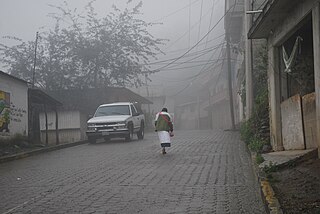
Guerrero, officially the Free and Sovereign State of Guerrero, is one of the 32 states that comprise the 32 Federal Entities of Mexico, located in Southwestern Mexico. It is divided in 81 municipalities. The state has a population of about 3.5 million people. It is bordered by the states of Michoacán to the north and west, the State of Mexico and Morelos to the north, Puebla to the northeast and Oaxaca to the east. In addition to the capital city, Chilpancingo and the largest city Acapulco, other cities in Guerrero include Petatlán, Ciudad Altamirano, Taxco, Iguala, Ixtapa, and Zihuatanejo. Today, it is home to a number of indigenous communities, including the Nahuas, Mixtecs, Tlapanecs, Amuzgos, and formerly Cuitlatecs. It is also home to communities of Afro-Mexicans in the Costa Chica region.

Morelos, officially the Free and Sovereign State of Morelos, is one of the 32 states which comprise the Federal Entities of Mexico. It is divided into 36 municipalities and its capital city is Cuernavaca.

Puebla, officially Free and Sovereign State of Puebla, is one of the 32 states which comprise the Federal Entities of Mexico. It is divided into 217 municipalities and its capital is the city of Puebla.

The Nahuan or Aztecan languages are those languages of the Uto-Aztecan language family that have undergone a sound change, known as Whorf's law, that changed an original *t to before *a. Subsequently, some Nahuan languages have changed this to or back to, but it can still be seen that the language went through a stage. The best known Nahuan language is Nahuatl. Nahuatl is spoken by about 1.7 million Nahua peoples.

Amate is a type of bark paper that has been manufactured in Mexico since the precontact times. It was used primarily to create codices.

The Camino Real de Tierra Adentro, also known as the Silver Route, was a Spanish 2,560-kilometre-long (1,590 mi) road between Mexico City and San Juan Pueblo, New Mexico, USA, that was used from 1598 to 1882. It was the northernmost of the four major "royal roads" that linked Mexico City to its major tributaries during and after the Spanish colonial era.

San Andrés Hueyapan is a small town in the rural northeastern part of the Mexican state of Morelos, formerly in the municipality of Tetela del Volcán. It lies at an elevation of ca 2000–2500 metres above sea level on the southern slopes of the active volcano Popocatépetl. To the west of Hueyapan runs the Amatzinac river, to the north is the Popocatépetl-Iztaccíhuatl natural reserve, and to the south the town of Tlacotepec and to the east is the municipality of Tochimilco which belongs to the state of Puebla located in the midlands.

Juan Nepomuceno Méndez Sánchez was a Mexican general, a Liberal politician and confidant of Porfirio Díaz, and interim president of the Republic for a few months during the Porfiriato. He served from 6 December 1876 until 17 February 1877.

La Huasteca is a geographical and cultural region located partially along the Gulf of Mexico and including parts of the states of Tamaulipas, Veracruz, Puebla, Hidalgo, San Luis Potosí, Querétaro and Guanajuato. It is roughly defined as the area in which the Huastec people had influence when their civilization was at its height during the Mesoamerican period. Today, the Huastecs occupy only a fraction of this region with the Nahua people now the most numerous indigenous group. However, those who live in the region share a number of cultural traits such as a style of music and dance, along with religious festivals such as Xantolo.
Zacapoaxtla is a city and seat of the Zacapoaxtla Municipality, in the Mexican state of Puebla. The city has a population of 8,062 inhabitants, while the municipality has 49,242 inhabitants at the 2000 census.

The Sierra Norte de Puebla is a rugged mountainous region accounting for the northern third of the state of Puebla, Mexico. It is at the intersection of the Trans-Mexican Volcanic Belt and the Sierra Madre Oriental, between the Mexican Plateau and the Gulf of Mexico coast. From the Mesoamerican period to the 19th century, this area was part of a larger region called Totonacapan, and area dominated by the Totonac people, extending further east to the Gulf of Mexico. Political maneuvers to weaken the Totonacs led to the region being divided between the modern states of Puebla and Veracruz with the Puebla section given its current name. Until the 19th century, the area was almost exclusively indigenous, with the four main groups still found here today, Totonacs, Nahuas, Otomis and Tepehuas, but coffee cultivation brought in mestizos and some European immigrants who took over political and economic power. While highly marginalized socioeconomically, the area has been developed heavily since the mid 20th century, especially with the building of roadways linking it to the Mexico City area and the Gulf coast.

Zacatlán is a city and municipal seat of Zacatlán Municipality located in the Sierra Norte de Puebla region of Puebla in central Mexico. The area is known for its production of apples, other fruit, cider and fruit wines, which are promoted through the annual Feria de la Manzana and Festival de la Sidra. It is also home to the Relojes Centenario company, the first clock factory in Latin America and the builder of the city's double sided flower clock in the main square. The historic center of the city is filled with traditional houses with red tile roofs and Zacatlan was designated a “Pueblo Mágico” in 2011. Outside of the city proper, there is a significant indigenous population, the Piedras Encimadas Valley with its rock formations and various waterfalls and ravines.

Huasca de Ocampo is a town and municipality of the state of Hidalgo in central Mexico. It is located 34 km from Pachuca and 16 km from Real del Monte in the Pachuca Mountains. While the town itself is just within the mountain range, much of the municipal land is located in a valley that opens up to the east of the town. While one of the first haciendas to be established in Mexico is located here, economic development started with mining haciendas built by Pedro Romero de Terreros in the 18th century. By the mid 20th century, none of these haciendas were in existence, having been broken up into communal farm lands and some even fully or partially under lakes created by dams. While agriculture remains important economically, the area has been promoted as a tourism destination, especially for weekend visitors from Mexico City, with attractions such as canyons, traditional houses, old hacienda facilities and waterfalls.

La Sierra Norte de Oaxaca is a heavily wooded region in the state of Oaxaca, Mexico. It is 62 km from the city of Oaxaca on Federal highway 175, heading east towards Tuxtepec. The region is divided into three districts: Ixtlán, which has 26 municipalities, Villa Alta, which has 25 municipalities and Mixe, which has 17 municipalities.

Apaxco is a municipality located in the Zumpango Region in Mexico. The municipal territory is located at a southern pass leading out of the Mezquital Valley about 288 km (179 mi) northeast of the state capital of Toluca. The name Apaxco comes from Nahuatl.

Villa del Carbón is a municipality located in the northern part of Mexico State, just northwest of Mexico City. While the town and municipal seat of Villa del Carbón is the largest in the municipality, it is not the oldest. The municipality contains a number of villages of Otomí and Nahua origins, in which much of the indigenous culture still survives. The municipality's territory was defined in 1714 when a region known as Chiapan, split into what is now Chapa de Mota and Villa del Carbón. At that time, however, the community which is now a municipal seat did not have an official name; it was known first only by the name of its church Nuestra Señora de la Peña de Francia, and later by being a major supplier of charcoal. This would lead to the name of Villanueva del Carbón de Nuestra Señora Santa María de la Peña de Francia, which eventually shortened to Villa del Carbón. The major portions of the municipality's glyph, which serves as it coat-of-arms, does not reflect the town of Villa del Carbón but rather two of its oldest communities: Taxhimay and San Lorenzo Pueblo Nuevo.

Pahuatlán, officially Pahuatlán del Valle, is a town and municipality located in the northwest of the state of Puebla in central Mexico. The municipality is part of the Sierra Norte region of the state, a steep mountainous area which receive significant moisture from the Gulf of Mexico, and borders the states of Hidalgo and Veracruz.

Zacatlán Municipality is a municipality in the Mexican state of Puebla in south-eastern Mexico. Its administrative centre is the city of Zacatlán.

San Pablito is a small town located on the side of the Guajalote Mountain in the Sierra Norte de Puebla mountain region in central east Mexico. It belongs to the Pahuatlán municipality of the state of Puebla. Culturally it is dominated by the Otomi although it is part of the La Huasteca region.

Juan Crisóstomo Bonilla Pérez was a Mexican general. He was born in Tetela de Ocampo, Puebla, and died in Veracruz.






















